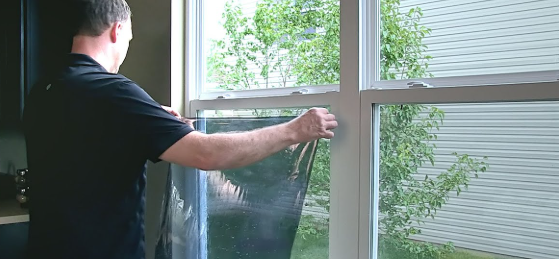Ever wondered how vehicles and buildings maintain clear, frost-free windows during cold seasons? That’s where electrically heated window film comes in. This innovative solution merges transparency, heating efficiency, and safety—all in one thin layer. Whether applied to cars, trains, or architectural glass, it provides warmth and prevents condensation without affecting visibility.
Let’s explore how it functions, what makes it so effective, and why it’s rapidly gaining attention in modern engineering and design.
Electrically heated window film is a transparent, conductive layer applied to glass surfaces to generate heat when powered by electricity. It transforms ordinary glass into electrically heated glass, capable of defrosting, de-icing, and keeping indoor spaces comfortable.
The film usually consists of fine metallic or conductive oxide coatings, laminated between protective layers. Once a voltage is applied, current flows across the conductive surface, producing uniform heat distribution. Because the heating elements are nearly invisible, it maintains optical clarity while providing active temperature regulation.
This technology is widely used in vehicles, skylights, display cases, and greenhouses—anywhere clarity and temperature control are equally important.

A heat control window film works by balancing solar energy transmission and electrical heating. It performs two roles simultaneously: blocking unwanted infrared radiation from the sun and producing gentle heat during cooler periods.
When powered, the conductive layer converts electrical energy into heat, which spreads evenly across the glass. This process reduces fogging, condensation, and frost formation. In summer, the film helps reflect part of the solar heat, keeping the interior cooler. In winter, it warms the glass surface, improving thermal comfort and reducing cold spots near windows.
The film can be connected to temperature sensors or automatic controllers, allowing the system to activate only when needed—an efficient solution for both residential and automotive applications.
Yes. One of the major advantages of electrically heated window film is its ability to retain heat inside. While it generates warmth through electrical resistance, it also enhances the insulation of the window.
By maintaining the glass surface at a higher temperature, the film prevents indoor heat from escaping. This minimizes energy loss through conduction and convection—key factors in winter heat leakage. Additionally, when paired with low-emissivity coatings, it improves overall thermal performance even further.

Yes, you can, but with caution. Applying tint to an electrically heated windshield requires selecting materials compatible with conductive coatings. Traditional metallic tints may interfere with electrical conductivity, reducing the heating film’s effectiveness or even causing uneven heat distribution.
The safest choice is non-metallic or ceramic-based tint films. These are designed to block ultraviolet and infrared rays without affecting the electric heating grid. They also reduce glare, enhance privacy, and maintain clear visibility at night.
Professional installation is strongly recommended. Specialists ensure that the tint film adheres correctly and that no air gaps or scratches compromise the heating function. So, while tinting is possible, it must be done with the right film and handled by experts familiar with heated glass systems.
Installing heat control window film involves precision, cleanliness, and a clear understanding of the electrical layout. Below are the key steps professionals usually follow:
While DIY kits exist, professional installation ensures longevity, safety, and uniform heating. Incorrect installation may cause localized overheating or poor adhesion.

The cost of electrically heated film varies depending on size, application, and customization needs. For small vehicle windows, it may range from $200 to $500 per unit, while larger architectural panels or skylights can exceed $1,000 each.
The electric window film cost also depends on whether it includes smart features like automatic dimming or remote temperature control. Advanced films combining solar control, heating, and smart-glass technology naturally cost more but deliver greater long-term energy savings.
While the initial investment may seem high, the reduction in energy loss, the elimination of defogging systems, and the improved comfort often lead to significant cost savings over time.
Electrically heated glass and window films represent a smart evolution in energy-efficient glazing. They enhance visibility, eliminate frost, and improve comfort—all while maintaining aesthetic transparency.
At Danyu Electronics, we specialize in precision-engineered heating solutions, including transparent heating films for skylights, vehicles, and industrial systems. Our products are manufactured under strict standards like ISO9001, IATF16949, and AS9100D, ensuring top-tier reliability for automotive, aerospace, and medical applications.
Each project is supported by professional engineering teams, advanced MES traceability, and competitive pricing to help our partners stay ahead in technology-driven industries.
If you’re seeking a dependable electrically heated window film manufacturer, Danyu Electronics delivers the expertise and quality you can rely on.
1. What voltage does electrically heated window film use?
Typically, it operates between 12V and 48V DC, depending on the size and heating capacity required.
2. Can the film be used on curved glass surfaces?
Yes. Modern flexible conductive films can conform to both flat and curved geometries without performance loss.
3. Is the film safe to touch when powered?
Absolutely. The outer surface temperature is regulated to remain safe for contact and does not cause burns.
4. How long does the film last?
With proper installation, most high-quality films can last over 10 years with stable heating performance.
5. Can electrically heated glass work with solar panels?
Yes. It’s compatible with renewable systems, making it an eco-friendly option for off-grid heating solutions.
Simply drop your email or phone number in the contact form, and we'll promptly reply you shortly.